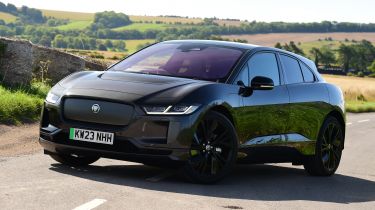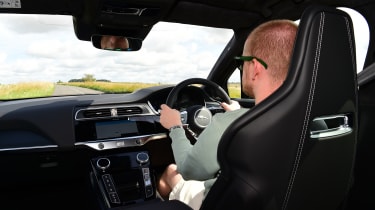Jaguar I-Pace review: performance, motor & drive
The Jaguar I-Pace is still one of the best-handling electric SUVs you can buy, with sharp steering and punchy acceleration
| 0-62mph | Top speed | Driven wheels | Power |
|---|---|---|---|
| 4.8s | 124mph | Four | 395bhp |
The I-Pace established a real benchmark for electric-car driving enjoyment when it launched in 2018 and only a few newer models have come along to touch it since. There’s a real sense of playfulness in its dialled-in responses and adjustable chassis. To this day it remains one of the most entertaining electrified SUVs out there – currently only the BMW iX betters it for driver reward.
Jaguar I-Pace electric motor, 0-62mph and acceleration
The Jaguar I-Pace has four-wheel drive courtesy of an electric motor on each axle. It delivers 395bhp and 0-62mph takes 4.8 seconds. While this is behind that of a Tesla Model Y Performance – not to mention the Model X Plaid – it’s more than enough for use on the roads, with the power being delivered in the same instantaneous fashion as other EVs.
Our only big criticism concerns brake feel. The I-Pace has regenerative braking, of course (in fact, you can choose between light or heavy ‘regen’ force), but whichever setting it’s in, the brake feel is short of precision; the pedal’s inherent sponginess makes it difficult to stop the car smoothly and precisely. At least the way the I-Pace automatically slows down when you lift off the accelerator is easy to get used to.
Handling
Jaguar is famed for its sports cars, but you might not expect some of the F-Type coupe’s DNA to find its way into the 2.2-tonne electric I-Pace.
We’re pleased to report, however, that Jaguar has worked its magic, with the I-Pace being just as enjoyable to drive now as it was when it first launched. The first thing you’ll notice is the heavy steering; this lets up just enough in more laid-back driving modes to make low-speed manoeuvres easy, but is sufficiently weighty in sportier settings to give you confidence to throw the car into a corner at high speeds and make use of the mountain of grip on offer.
This is all thanks to the two electric motors that shuffle power between the front and rear wheels of the I-Pace, and also to the low-set batteries that are arrayed along the car’s floorpan to keep the centre of gravity low. Our biggest gripe is that the ride is on the firm side, particularly at low speeds, but it doesn’t make the car overly uncomfortable. The optional air suspension is worth considering, as it helps the ride settle at higher speeds and takes the edge off the thuds from potholes.
The four-wheel drive isn’t there just to make the I-Pace good to drive on a decent country road; Jaguar has also taken some Land Rover know-how to give it some off-road capability. All Surface Progress Control (ASPC) is a bit like cruise control for bad terrain – it’ll keep the I-Pace going over a muddy field and moderate the car’s speed down a stony descent. The I-Pace is no Land Rover Defender when it comes to off-roading, but it’ll cope easily enough if you regularly negotiate unpaved tracks.





